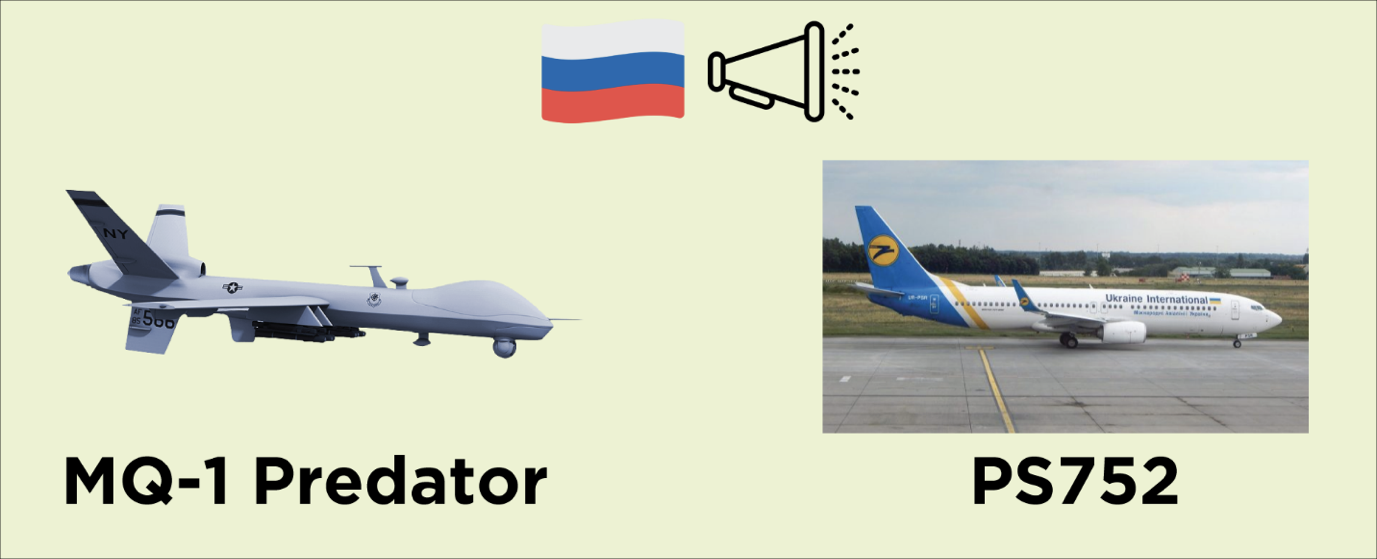Russian media pushed U.S. drone conspiracy related to plane crash in Iran
The unfounded theory blamed a U.S. drone strike for downing the Ukrainian Airlines Flight 752 near Tehran
Russian media pushed U.S. drone conspiracy related to plane crash in Iran

The unfounded theory blamed a U.S. drone strike for downing the Ukrainian Airlines Flight 752 near Tehran

After Iran accidentally shot down Ukrainian International Airlines Flight 752 (PS752) during a time of high tension with the United States, Russian fringe media outlets picked up a conspiracy theory that the United States had brought down the plane with a drone strike.
This would not be the first time that Russian media explicitly ignored widely known facts about a plane being shot down. It is internationally acknowledged, thanks in part to extensive reporting by open-source research outlet Bellingcat, that Russia was responsible for the shootdown of Malaysian Airlines Flight 17 (MH17) in eastern Ukraine in July 2014, yet Russia continues to deny any involvement in the crash. Indeed, it still actively blames Ukraine for the shootdown of MH17. Putting an argument forward that anybody other than Iran was responsible for the recent PS752 shootdown allows Russia to maintain its narrative of innocence around the earlier MH17 shootdown.
According to Flight Radar, on January 8, 2020, PS752 had just departed en route to Kyiv from Tehran when it lost contact two minutes after takeoff and crashed near the city of Parand, southwest of Tehran. Initially, Iran and its affiliated media incorrectly claimed the crash was the result of a mechanical failure of some kind. On January 11, Iran’s President Hassan Rouhani admitted that the plane had been shot down by the country’s military “due to human error” after several world leaders and experts suggested Iran was at fault.
After Rouhani’s admission, Russian fringe media outlets nevertheless doubled down on the drone strike theory, which first appeared on South African clickbait outlet Live Report but failed to gain significant attention until it was picked up by pro-Kremlin media.
A South African origin
The unfounded theory originated on South African clickbait website Live Report. Most of the articles in Russian in the DFRLab’s analysis did not directly link to the Live Report article but referred to the outlet in the text. The article in question cited an “Iranian military source” as saying that Flight 752 may have been shot down by an MQ-1 Predator unmanned aerial vehicle (UAV), a drone “now in service only in the U.S. military.” The article did not receive wide traction on Facebook or Twitter, and none of the major media outlets corroborated the account provided by Live Report’s Iranian military source.

Russian media pick up the narrative
Despite generating little organic traction, the Live Report article received massive attention from Russian media. The first mention appeared on a website called Nation News, an outlet that recently joined Kremlin-affiliated media group “Patriot,” whose board of trustees is chaired by close Kremlin ally Yevgeny Prigozhin, the owner of the notorious Internet Research Agency troll factory in Saint Petersburg.
Another outlet from the conglomerate RIAFAN also published the story, relying on the Live Report article as the main source of evidence. RIAFAN’s article also noted U.S. forces shot down an Iranian airliner in 1988, mentioned that several U.S. airbases in the region could be used to launch a drone strike, and pointed out that, minutes before the crash, U.S. President Donald Trump’s had tweeted that he would make an “announcement.” Finally, the article quoted a political analyst on Trump’s “intention” to start a war with Iran.

On January 8, Tsargrad TV, a pro-Kremlin Christian channel that has previously been accused of spreading false information, published a short article recycling the Live Report piece. The article received 121 shares and 393 reactions on Facebook and 1,234 interactions on Twitter, which was significantly wider engagement than the Nation News, RIAFAN, and original Live Report pieces received. The next day, on January 9, both Tsargrad TV and RIAFAN released follow-up pieces citing Vladimir Shapovalov, a history and politics expert from the Moscow State Pedagogical Institute, saying that U.S. involvement should not be excluded given its active military presence in the region and the shootdown of an Iranian plane by the United States in 1988.

Some users started promoting the drone strike theory on social media, including by replying to U.S. government accounts and international media outlets.
The initial narrative — that a U.S. drone shot down the commercial jet with an air-to-air missile, but the United States then blamed Iran — subsequently mutated into many conflicting variations. One variation claimed that the drone intentionally collided with the plane; another claimed that an Iranian missile intended for the drone accidentally hit the plane instead.

Similar messages appeared in the pro-Kremlin Telegram channels of Russian-state media journalists and received thousands of views. Pro-Kremlin journalists voiced doubt over the verified facts, as confirmed by Iran’s admission, that an unintentional surface-to-air missile shot down the plane due to human error, criticized a recent Bellingcat investigation of videos and imagery from the plane crash, and claimed that Trump was hiding something during his January 8 address to the nation.
In the end, this was only a single narrative among a flood of anti-U.S. narratives to emerge amidst the chaos of the U.S.-Iran crisis. The narrative did not gain much traction beyond the Russian language. Indeed, prior to Russian outlets’ interest, the narrative had attracted very little attention in general.
Follow along for more in-depth analysis from our #DigitalSherlocks.

